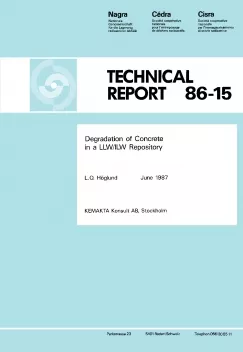
Technical Report NTB 86-15
Degradation of Concrete in a LLW/ILW Repository
The release rate of radionuclides from a Type B repository depends on the long-term properties of the concrete. The critical properties of the concrete are diffusivity and hydraulic conductivity.
From calculations assuming a groundwater flow through the repository, it has been concluded that, besides the obvious risk of a fast nuclide release, the rate of concrete deterioration would also be increased compared to a situation where transport through the technical barriers takes place by diffusion only.
The deterioration of concrete by aggressive species in the groundwater except by carbonation has been found to be less important than leaching by water. Also, possible chemical attack by sulphate, which is an expected constituent of the waste, could be reduced by the choice of a sulphate-resistant concrete.
By appropriate design of barriers, the flow of groundwater through the repository can be minimized. This would assure that the only possible mass transfer mechanism would be diffusion. This would also decrease the influence of carbonation to an insignificant level. The rate of deterioration is low in this case.
The possibility of microbial degradation of concrete has not been considered in this report.
